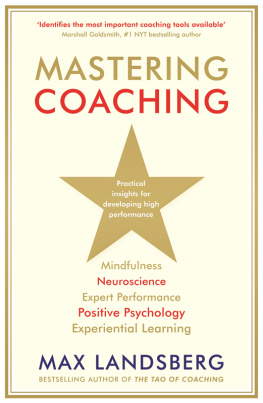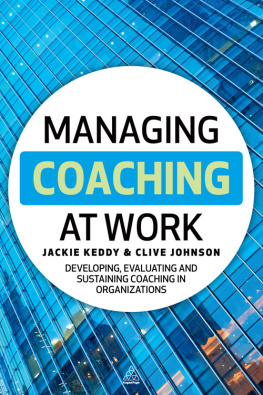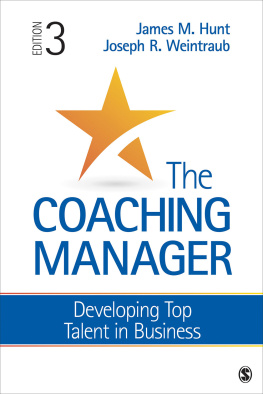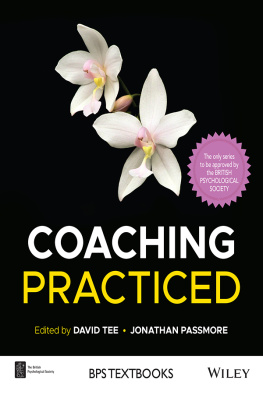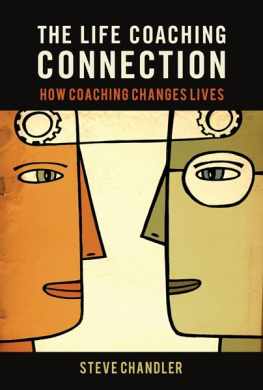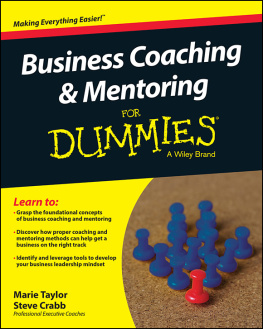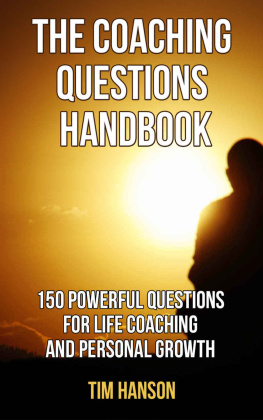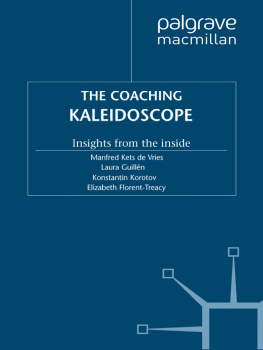THE 7 MOMENTS OF COACHING
STORIES OF INNER JOURNEYS
THE 7 MOMENTS OF COACHING
STORIES OF INNER JOURNEYS
Edited by
Alberto Ribera
MD PhD, Professor of the Practice of Management in the Managing People in Organizations Department of IESE Business School Academic Director of the Coaching Unit, IESE Business School
Co-editors
Alan McFarlane
Executive coach, collaborator with the Coaching Unit, IESE Business School
Nia Plamenova
PhD, Researcher in the Managing People in Organizations Department and the Coaching Unit, IESE Business School
Estbalitz Ortiz
PhD, Executive Director of the Coaching Unit, IESE Business School
Prologue by Carol Kauffman
Faculty, Harvard Medical School
Founder, Institute of Coaching
President, Coaching Psychology LLC
The 7 Moments of Coaching
IESE Publishing, 2020
All rights reserved.

This book has been published thanks to IESE with the collaboration of:
Alberto Ribera (editor)
Alan McFarlane (co-editor)
Nia Plamenova (co-editor)
Estbalitz Ortiz (co-editor)
Enrique Escauriaza
Jordi Navarrete
Current edition:
Editorial Revert, S. A., 2020
Loreto 13-15, Local B. 08029 Barcelona Espaa
Tel.: (+34) 93 419 33 36
www.reverte.com
reverte@reverte.com
Ebook edition
ISBN: 978-84-291-9580-4 (ePub)
ISBN: 978-84-291-9581-1 (PDF)
Paper edition
ISBN: 978-84-17963-14-9
Editors: Ariela Rodrguez / Ramn Revert
Layout: Patricia Revert
Jacket design: Hermanos Berenguer
Digitalizacin: Revert-Aguilar
The total or partial reproduction of this work, by any means or procedure, including reprography and computer processing, is strictly prohibited, except for the exemptions allowed by law. It is also forbidden to distribute copies by means of rental or public loan, to communicate to the public and to transform any part of this publication without the prior authorization of the owners of the intellectual property and of the Publisher.
# 39
TABLE OF CONTENTS
INTRODUCTION:
INTEGRATIVE COACHING
Alberto Ribera
Martin Bettels
Michael Brandenburg
Patricia Ferrando
Esther Marugn
Mariano Vilallonga
Enrique Escauriaza
Sebastin Fernndez
Carlos Oliveira
Marta Salgado
Teresa van Oorschot
Estbalitz Ortiz
Alan McFarlane
PROLOGUE
Carol Kauffman, PhD PCC ABPP
The 7 moments of coaching is a unique little book and I suggest you read it. and here is how: youll read what a leader tells the coach. Stop right then. Imagine what you might say at that moment. Then imagine another thing you might ask. Then read on. Any coaching session is a labyrinth of choices. Contrasting where your question would have taken the coaching, and where the coaching actually went is eye-opening. The book centers us in each of the moments, shows us what can happen and illustrates how simplicity can be found on the far side of complexity.
Out of the mouths of babies
The father asks the little girl, What time is it?
With great authority, she announces, Its Now!
What time is it? Now? Yes. Now.
Change happens in the present. The intersection of past and future. We are the oldest weve ever been, and the youngest well ever be. Choice happens in this moment.
The IESE team captures 7 archetypical moments in coaching. These are the key types of experiences that are pivotal in the life of the leaders we coach. The book walks us through actual coaching encounters. These are riveting, real moments. As a leaders problem is introduced, I find myself having that sinking feeling you can get hearing the depth and breadth of a challenge. As I read on, I find myself inspired by the coaching skills I get to witness firsthand. These are the kinds of interactions that only take place behind closed doors and here the doors open wide for us to learn from masterful coaches.
My copy of this book is densely underlined to help me find things I do not want to forget. Focus especially on the questions the coaches ask. The explanations of the interventions afterward deepen the learning. While not the focus of the book, the theories behind the interventions are quite solid.
Now, bear with me a moment. Ive had tens of thousands of hours of coaching experience with CEOs, C-Suite leaders and the executive committees of a few of the worlds largest and most complex organizations. Ive taught coaching and positive psychology to hundreds of leaders, been on the Harvard faculty for over twenty-five years and founded the Institute of Coaching and was the founding co-editor in chief of the first coaching journal affiliated with a major publishing house. In other words, Ive seen a lot. Im not easily impressed. Ive learned more from this small book than I have from any other book in years. In addition, due to the way this book is written, it is equally beneficial for the new coach, or a leader interested in getting to see what coaching is about.
Show, dont tell
The art of great fiction writing is to show what is happening and what people are thinking and feeling without saying things like Michael looked unhappy. Instead, one should paint the picture and write something like, his shoulders slumped, or his eyes darted back and forth like he was reading something in the sky. If you are writing a case, try it, it is incredibly difficult to do! (Ive tried.) But more than any other form of writing, it brings the scene before us to life. It is fresh.
What is most unusual about this book is somehow nearly all the authors are able to accomplish this type of communication. They show us what they saw, captured what they said and allow us to decide what we think. Only at the end of each chapter do the authors add a tell section that illuminates the implicit beliefs and techniques guiding the coaching. At that point, you may want to read the chapter again. Two moments, in contrast, are an overview or reflections of the arc of the coaching and capture how the coach is thinking about the leader in a way that is also instructive.
Simplicity on the far side of complexity
In the end, I find this book humbling and a good course correction. By now, Ive logged enough hours that I have very quick pattern recognition. When an issue comes up, Im pretty sure I know where the conversation will go. Similar to Moment 3, example 2, the story of Aida, I often have to give a leader bad news, 360 results or convey what their board or executive committee is actually thinking. Typically, it goes well, humor helps and until reading this, Ive felt pretty self-satisfied with how I handle this kind of encounter. Until this moment that is. Now, I think I narrow things too quickly in order to help move things forward and miss potential avenues of exploration.
The story of Aida and her coach begins with the two of them in her office exploring negative 360 feedback about her communication style and stress management issues. Almost as if on cue, one of her direct reports bursts into the room to schedule what he feels is an urgent meeting. She lets the intruder have it with both barrels adding that she doesnt have time, clients come first, and after he leaves she announces to her coach how selfish the report is, and adds and they call ME unemphatic!



